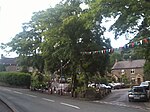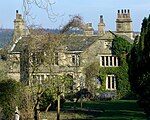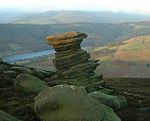Hordron Edge stone circle
Stone circles in Derbyshire

Hordron Edge stone circle, also known as 'The Seven Stones of Hordron' is a Bronze Age stone circle (grid reference SK2152486851) in Derbyshire, England. It is on the edge of Moscar Moor. Ladybower reservoir is to the west, and Moscar Cross is to the northeast. Seven stones are presently (2017) visible with a further three stones, now recumbent and hidden discovered in 1992. Some authorities believe that the circle might have once comprised 26 stones.The stone circle is approximately 15 to 16 m (49 to 52 ft) in diameter, with eleven stones between 45 cm and 95 cm high extant upright.
Excerpt from the Wikipedia article Hordron Edge stone circle (License: CC BY-SA 3.0, Authors, Images).Hordron Edge stone circle
Manchester Road, High Peak Derwent
Geographical coordinates (GPS) Address Nearby Places Show on map
Geographical coordinates (GPS)
| Latitude | Longitude |
|---|---|
| N 53.378055555556 ° | E -1.6780555555556 ° |
Address
Hordron Edge Stone Circle
Manchester Road
S33 0AX High Peak, Derwent
England, United Kingdom
Open on Google Maps











